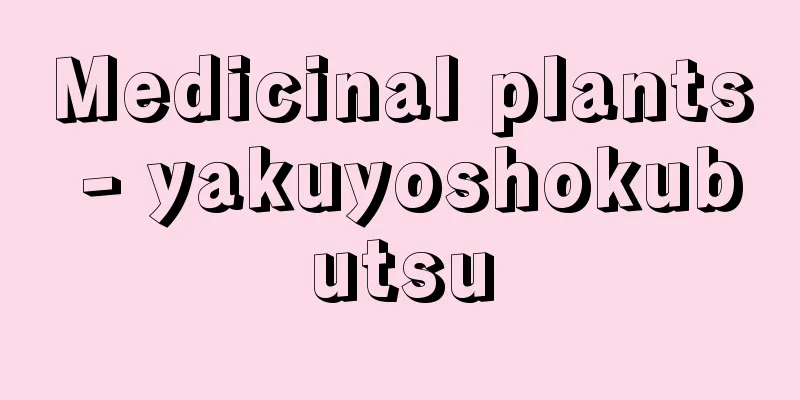Medicinal plants - yakuyoshokubutsu

|
A medicinal plant is a plant used as a medicine, and can also be considered the source plant of herbal medicines. In other words, a medicinal plant is a plant that, in whole or in part, has some medicinal effect on humans or other animals, or is used because it is believed to have such effect. Commonly called medicinal herbs, this includes woody plants and fungi such as mushrooms, and in a broader sense, can also include bacteria that produce drugs such as antibiotics. Also, while a plant is not considered medicinal in its own right, it may be medicinal when its chemical components are synthetically altered, or its secretions or galls may have medicinal properties; these are sometimes called medicinal resource plants. Even edible or poisonous plants are classified as medicinal plants if they are used for medicinal purposes. Medicinal plants are used all over the world, and the types and methods of use vary depending on the region. Although it is not an accurate statistic, in fact, about 10-15% of the world's higher plants (vascular plants including ferns) are used for medicinal purposes somewhere in the world, and the number of types is extremely large. Fresh plants or dried and preserved plants are used for medicinal purposes, and the most common methods of use are as follows: (1) The medicinal parts are used as is, or lightly kneaded or crushed, and then used externally. (2) The pounded juice or squeezed oil is used externally and internally. (3) The plants are infused or boiled in water or alcohol, and then used externally and internally. (4) The plants are powdered and used externally and internally, or made into snuff (snuff). (5) The plants are fermented and the liquid is used internally. (6) The plants are extracted with oil and used externally. (7) The aqueous extract is used after drying. [8] It is burned or used as tobacco, and the resulting smoke is applied to affected areas or inhaled, or used as an insect repellent. [9] It is burned to a black color or turned to ashes for use. [10] It is used as a bath additive, either in baths or steamed with it. [11] The essential oil obtained by steam distillation is used. [12] It is cooked or eaten fresh in dishes (medicinal food). [13] Special chemical components are extracted and used either as is or with their structure modified through synthetic chemicals (modern medicine). In addition to these methods, there are many unique usage examples depending on the country or region. It is thought that the discovery of medicinal plants in ancient times was an instinctive process that occurred through the recognition of edible plants and poisonous plants, but the character "服" ("to take"), used in the word for taking medicine, originally meant to be worn, and the most primitive way of using medicinal plants was to wear them as a talisman. This method remains in many developing countries today. There are several ways to classify medicinal plants, including (1) by botanical taxonomy, (2) by medicinal effects, (3) by differences in the region or ethnic group in which they are used, (4) by the part of the plant that is used for medicine, and (5) by the ingredients they contain, but apart from the botanical taxonomy method, each method has its own advantages and disadvantages, such as the same plant being classified under multiple categories. In Europe and Japan, botanical taxonomy is often used, but in modern China, classification based on medicinal effects in traditional Chinese medicine is common. Plant resources are essentially infinite resources, and if harvested in a planned manner, they should never run out. However, in recent years, environmental destruction has progressed rapidly in developed countries, and overharvesting in producing countries has led to serious discussions about the issue of securing medicinal plant resources. Many species are cultivated as economic plants, but on the other hand, there are many issues that remain to be addressed, such as unstable prices, residual pesticide issues, and medicinal problems. In addition, due to the recent boom in medicinal plants and natural foods, there has been an increase in cases of poisoning from accidentally collected poisonous plants. It is convenient to use medicinal plants that are close by, but it is very dangerous to use them with only a limited knowledge. It is important to avoid using plants that you are unsure about, or to consult with experienced people to prevent accidents. [Tsuneo Namba and Masayuki Mikage] "Encyclopedia of Medicinal Plants" edited by Karima Tatsuo and Kimura Koichi (1958, Hirokawa Shoten)" ▽ "Latest Japanese and Chinese Medicinal Plants" by Karima Tatsuo (1959, Hirokawa Shoten)" ▽ "Colored Illustrated Guide to Japanese Medicinal Plants" completely revised new edition by Kimura Koichi and Kimura Taketsune (1981, Hoikusha)" ▽ "Medicinal Plants I-III" by Sato Junpei, Miura Saburo and Namba Tsuneo (1956-79, Sogensha)" ▽ "Encyclopedia of Everyday Medicinal Plants" by Izawa Bonjin (1973, Shufu to Seikatsusha)" ▽ "Medicinal Plants that Changed the World" by N. Taylor, translated and annotated by Namba Tsuneo and Namba Yoko (1972, Sogensha)" ▽ "Everyday Medicinal Plants" by Namba Tsuneo and Mikage Masayuki (Hoikusha, Color Books)" [References] |Source: Shogakukan Encyclopedia Nipponica About Encyclopedia Nipponica Information | Legend |
|
薬として用いる植物のことで、植物性生薬(しょうやく)の原植物ともいえる。すなわち、薬用植物とは、植物のなかで全体あるいはその一部分が、人あるいは他の動物に対してなんらかの薬効を有するもの、あるいは有するとの考えから使用されるものをいう。俗に薬草ともよばれるが、これには木本植物やキノコなどの菌類も含まれ、さらに広義には抗生物質をはじめとする薬物を生産する細菌類も含まれることがある。また、そのままでは薬用とされないが、含有する化学成分を合成化学的に変化させたものが薬用となる場合や、分泌物、虫こぶなどが薬用となる場合もあり、これらは薬用資源植物とよばれることもある。食用植物や有毒植物であっても、薬用として利用される場合には薬用植物に分類される。 薬用植物は世界の各地で使用されており、その土地によって利用される植物の種類や利用方法は異なる。正確な統計ではないが、実際には全世界の高等植物(シダ類を含む維管束植物)中、約10~15%が世界中のどこかで薬用にされており、その種類はきわめて膨大といえる。薬用には新鮮品あるいは乾燥保存したものが利用され、代表的な利用方法には次のようなものがある。〔1〕薬用部をそのままか、あるいは軽くもんだり搗(つ)き砕いて外用する。〔2〕搗き汁あるいは絞った油を外・内用する。〔3〕水またはアルコールで冷浸あるいは煎(せん)じて外・内用する。〔4〕粉末にして外・内用するか、あるいはスナフ(嗅(か)ぎたばこ)とする。〔5〕発酵させてその液を内用する。〔6〕油で抽出して外用する。〔7〕水性エキスを乾燥したものを利用する。〔8〕火中に入れるか、たばことして用い、生じる煙を患部に当てたり吸引したりするほか、昆虫忌避剤ともする。〔9〕黒焼きあるいは灰にして利用する。〔10〕浴湯料として沐浴(もくよく)したり湯気で蒸したりする。〔11〕水蒸気蒸留して得られる精油を利用する。〔12〕調理するか、あるいは新鮮なままで料理として食する(薬膳(やくぜん))。〔13〕特殊な化学成分を抽出し、そのままか、あるいは合成化学的に構造を変化させたものを利用する(近代医学)。 これらの方法以外にも、国や地域によって特殊な用例が数多くみられる。 古代における薬用植物の発見は、食用植物と有毒植物の認識のなかから本能的にみいだされたものと想像されるが、薬物を摂取する場合に用いる「服用」の「服」の字は、本来は身につけるという意味であり、薬用植物のもっとも原始的な利用法は、魔除(まよ)けとして身につけることであった。この方法は、現代においても多くの開発途上国に残っている。 薬用植物の分類方法としては、〔1〕植物分類学的手法による、〔2〕薬効による、〔3〕使用される地域あるいは民族の違いによる、〔4〕薬用植物の利用部位による、〔5〕含有成分による、などがあるが、植物分類学的な手法以外は、同一植物が複数の項目を重複するなど、それぞれに一長一短がある。ヨーロッパや日本では植物分類学的手法によることが多いが、現代中国では漢方医学的な薬効による分類法が一般的である。 植物資源は本来無限資源であり、計画的に収穫すれば永遠に資源の枯渇はないはずである。しかし、近年、先進国においては自然破壊が急速に進み、また生産国の乱獲もあって、薬用植物の資源確保問題が深刻に論議されるようになってきた。経済植物として栽培される種類も多いが、一方では価格が不安定であったり、残留農薬の問題や薬効的な問題など、今後に残された課題も多い。なお、最近の薬草ブームや自然食ブームの影響で、誤って採集した有毒植物による中毒例が増えている。身近にある薬用植物の利用は便利ではあるが、なまはんかな知識で利用するのは非常に危険である。自信のない植物は使用しないか、経験豊かな人に相談するなどして事故がないように心がけることがたいせつである。 [難波恒雄・御影雅幸] 『刈米達夫・木村康一監修『薬用植物大事典』(1958・広川書店)』▽『刈米達夫著『最新和漢薬用植物』(1959・広川書店)』▽『木村康一・木村孟淳著『原色日本薬用植物図鑑』全改訂新版(1981・保育社)』▽『佐藤潤平・三浦三郎・難波恒雄著『薬になる植物I~Ⅲ集』(1956~79・創元社)』▽『伊沢凡人著『身近な薬草百科』(1973・主婦と生活社)』▽『N・テーラー著、難波恒雄・難波洋子訳注『世界を変えた薬用植物』(1972・創元社)』▽『難波恒雄・御影雅幸著『身近な薬用植物』(保育社・カラーブックス)』 [参照項目] |出典 小学館 日本大百科全書(ニッポニカ)日本大百科全書(ニッポニカ)について 情報 | 凡例 |
<<: Medicated soap (English spelling)
Recommend
Cabinet hierarchy - Cabinet hierarchy
…As members of the Cabinet, the ministers have eq...
Saeko Ozuki
1922-2012 An actress from the Showa era. Born Dec...
Records of the Date clan
The official history of the Date clan, feudal lord...
Wang Siyi - Oushigi
...It has a preface from 1607 (the 35th year of t...
Suraj Mal (English spelling)
…Unlike the Rajputs, they did not form a kingdom ...
Banquet - Kyoou
〘Noun〙① To go along with someone's wishes with...
Educational welfare work staff training institute
...Reformatory schools are the successors of refo...
Mr. Mizuno - Mizunouji
A local lord of Owari Province (Aichi Prefecture)...
Surcot (English spelling) [France]
In English, it is called a surcoat. It is an outer...
Spotted bat - Spotted bat
A moth belonging to the order Lepidoptera and fam...
Baillarger, J.
...It was the German psychiatrist Kraepelin who m...
Malonic acid - Maronsan (English spelling)
It is an aliphatic dicarboxylic acid. It is found...
William Edward Burghardt Du Bois
1868‐1963 A mixed race American black movement lea...
Academia Platonica - Academia Platonica
…In the 15th century, the collapse of the Byzanti...
Hiroyuki Kato
A Meiji period scholar of national law. Born on J...









